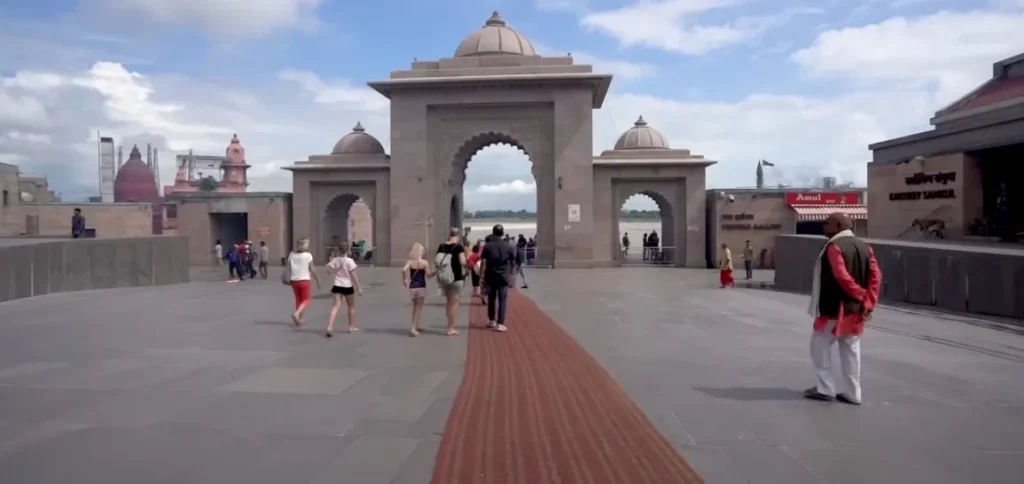The Banaras Corridor, also known as the Kashi Vishwanath Corridor, is a key project in Varanasi, India. It links the famous Kashi Vishwanath Temple to the Ganges River. This makes it easier for pilgrims to visit both places. Let’s dive into the details of the Banaras Corridor.

Historical Significance
The Kashi Vishwanath Temple is a major Hindu temple dedicated to Lord Shiva. It has been a key pilgrimage site for centuries. The Banaras Corridor was built to create a direct path from the temple to the Ganges River.
Prime Minister Narendra Modi started the project in 2019. It was finished in 2021.
Why Was the Banaras Corridor Built?
The main goal was to make it easier for pilgrims to visit the temple. Before, visitors had to go through narrow and crowded streets. Now, they can walk on a wide, beautiful path to the Ganges River.
The corridor has wide walkways and ramps. This makes it easy for everyone, including those with disabilities, to get to the temple.
The project includes a tourist information center, public restrooms, food courts, and seating areas. These facilities are for visitors.
The corridor’s modern design aims to attract more tourists. This will help the local economy and promote cultural exchange.
The corridor was opened on December 13, 2021.
The total cost of this big project is around ₹800 crores (about $107 million).
Impact on Local Residents
The construction of the Banaras Corridor had a big impact on local residents:
Over 300 houses were torn down for the corridor. This displaced many families who had lived there for generations. Many residents felt a deep emotional loss, leading to protests against the project.
The demolition hurt local businesses, mainly shops for pilgrims. Many shopkeepers lost their income, causing economic hardship.
Some residents got compensation, but it often didn’t match the value of their lost homes or businesses. This left many feeling uprooted and worried about their future.
Architectural Wonder
The Banaras Corridor is a stunning mix of modern and traditional architecture. It is 75 feet wide and covers an area of 5 lakh square feet. It connects the temple to the Lalita Ghat on the Ganges River.
The corridor can hold 50,000 to 75,000 devotees at once. This makes it easier for pilgrims to move around without feeling crowded.
The corridor has beautiful pathways, gardens, and seating areas for visitors. The temple and corridor lighting is beautiful, making it even more special at night. The blue theme lighting keeps the heritage of the temple alive.

Ancient Temples Discovered During the Banaras Corridor
During the Banaras Corridor project, a total of 40 ancient temples were found and restored. Here are temples that were uncovered and restored:
1. Manikarnika Vinayak Temple
2. Jauvinayak Temple
3. Gangeshwar Mahadev Temple
4. Shwet Vinayak Temple
5. Neelkanth Mahadev Temple
6. Kubereshwar Mahadev Temple
7. Manikarnika Mahadev Temple
8. Tarakeshwar Mahadev Temple
9. Rameshwar Mahadev Temple
10. Bhairav Nath Temple
11. Madhyameshwar Mahadev Temple
12. Vishalakshi Temple
13. Shani Vinayak Temple
14. Vishwanath Temple
15. Annapurna Temple
16. Kashi Karvat Temple
17. Kedareshwar Mahadev Temple
18. Siddheshwar Mahadev Temple
19. Siddhivinayak Temple
20. Bhairav Vinayak Temple
21. Shiv Vinayak Temple
22. Shiv Shakti Temple
23. Shiv Durga Temple
24. Shiv Parvati Temple
25. Shiv Gauri Temple
26. Shiv Shambhu Temple
27. Shiv Shankar Temple
28. Shiv Bhole Temple
29. Shiv Ganesh Temple
30. Shiv Bhairav Temple
31. Shiv Vishnu Temple
32. Shiv Hanuman Temple
33. Shiv Krishna Temple
34. Shiv Ram Temple
35. Shiv Lakshmi Temple
36. Shiv Saraswati Temple
37. Shiv Kartikeya Temple
38. Shiv Ganesha Temple
39. Shiv Nandi Temple
40. Shiv Bhairav Nath Temple
These temples were hidden in Varanasi’s crowded streets. Now, they show off the city’s rich culture and faith.
Travel Tips
The corridor is open 24/7 for visitors.
There is no entry fee to visit the corridor.
Visitors should dress modestly, covering their shoulders and knees. Sleeveless shirts and shorts are not allowed.
Photography is allowed for personal use, but it is best to avoid taking pictures during prayers.
The best times to visit the Banaras Corridor are early in the morning or late in the afternoon when the weather is cooler. This will also help you avoid the crowds and enjoy a peaceful visit.
Final Thoughts
The Banaras Corridor is a fascinating place that connects history, culture, and spirituality. It’s a perfect destination for anyone who wants to learn more about India’s rich heritage. Whether you are exploring its beautiful ghats, tasting local foods, or discovering ancient temples, there’s something for everyone in Varanasi.
So, if you ever get a chance to visit this magical city, make sure to check out the Banaras Corridor! It’s an adventure you won’t forget!
We hope this post has inspired you to learn more about the Banaras Corridor and the incredible city of Varanasi. Remember, every place has its own story to tell and Varanasi is full of stories waiting for you to discover!
1 thought on “Banaras Corridor: A Gateway to History and Devotion”